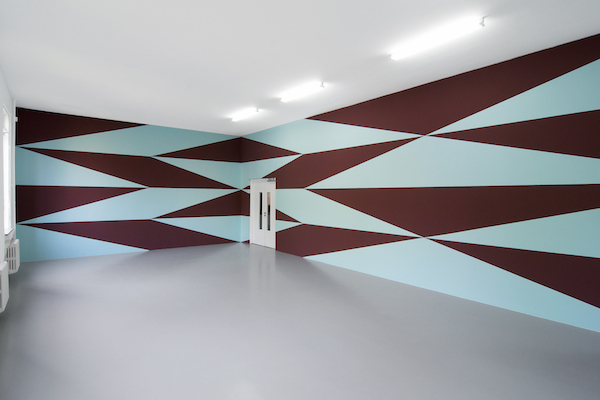
Jan van der Ploeg, WALL PAINTING No.357, Untitled, 2013, acrylic on wall, 368 x 2245 cm
On the surface, there could not be two more different exhibitions. Downstairs at Perth Institute of Contemporary Arts (PICA), David Rosetzky’s True Self, on tour from Melbourne’s Centre for Contemporary Photography, uses the cavernous main gallery as a host body, exploring uncertain identities and authenticity in a retrospective of photographs and videos. Upstairs for One Place After Another: AC4CA, a group of Western Australian and international artists responds to the legacies of modernism and minimalism, using the building itself as a canvas for a new body of hard-edged abstraction. Each exhibition works as a palate cleanser for the other: if you overdose on the large-scale architectural optics upstairs you can recuperate downstairs with Rosetzky’s comforting neutrals and human-scale concerns. Too much introspection or subjectivity can be balanced with the certainty of the purely retinal.
The characters in David Rosetzky’s videos and photographs, even when played by famous actors, have the sense of being interchangeable, both with their fellow characters and those in other works. In < 3 forever this occurs literally: two lovers wander the countryside, unbothered by the occasional replacement of each protagonist with someone of an entirely different hair colour or build, even the opposite gender. Rosetzky’s intimate, universal and unreliable narratives play out over roughly three hours of video and a number of photographs, and his ideas find their most complete and elegant form in the cyclical, movie-length video work How to feel.

David Rosetzky, Kiah, 2008. Type C digital print collage, Edition 6 of 6. Courtesy the artist and Sutton Gallery, Melbourne
Although Rosetzky’s characters appear to reveal private desires and motivations, the delivery of their lines has a relaxed and choreographed uniformity that gently undermines any personal content. They speak as though to a therapist or confidant after the fact: careful and disconnected. In dramatic terms, ‘players’ is perhaps a better description than ‘characters’, the former suggesting a knowing and changeable vessel rather than a defined individual. Thoughts are constructed around the idea of authenticity rather than authentically, evolving but never volatile, suggesting a yearning for connection, but not too much. The actors are not a group of homogenous drones so much as an endlessly adaptable community of players. Uniform audience seating and screen casings designed for each video extend the neutrality and modular individuality of the works.
AC4CA, in contrast, wants nothing of unreliable narrators or confessional monologues. One place after another is the first Australian survey of the group, which in its current incarnation consists of 12 artists, based in Fremantle but with international connections. In Fremantle AC4CA’s work is immediately recognisable, produced large-scale on publicly visible walls and responding with hard, pure and minimal colour and form to the proportions and surface of each location. This same approach has been applied to the entirety of PICA’s upper galleries and its lower entry, with wall-to-wall murals and the occasional protruding structure creating an immersive, ‘total’ environment.

Jan van der Ploeg, WALL PAINTING No. 341, Untitled, 2012, acrylic on wall, 302 x 791 cm
The group invokes Theo Van Doesburg’s 1930 manifesto The Basis of Concrete Art, which championed a cerebral abstraction without reference to the representational world and without sentiment. Concrete art simply ‘is what it is’, a phenomenological experience of form and space. References to digital coding and typography occasionally creep in, and each artist has their own idiosyncrasies – Jurek Wybraniec’s signature yellow, David Tremlett’s luxurious tactile slabs of grease and pastel, Guillaume Boulley’s subtle use of sculptural white and grey – but that manifesto, still functional 80-odd years later, feels written under the surface of each work. Such close commonality of thought and method means the total effect is unified, rhythmic and, despite the saturation and scale of colour and pattern, strangely peaceful. In this sense, One Place After Another reads as a singular whole, and like Rosetzky’s True Self, conveys a multitude of voices from a variety of perspectives, calmly intoning an ever-adaptable truth.
True Self: David Rosetzky Selected Works & One Place After Another: AC4CA, Tues to Sun 10am-5pm until 21 December 2014; Perth Institute of Contemporary Arts, 51 James Street, Northbridge WA; (08) 9228 6300, pica.org.au
